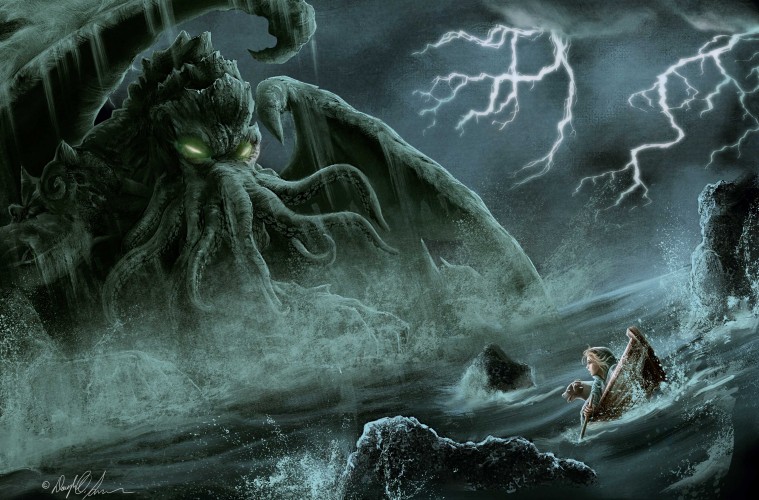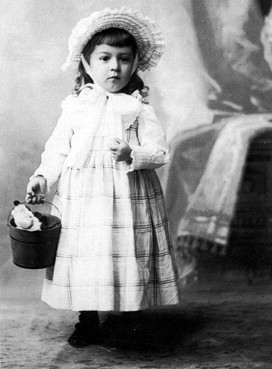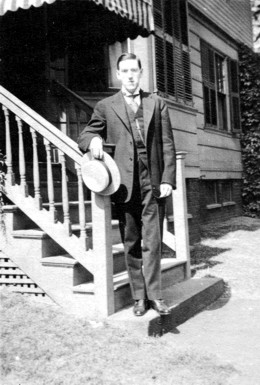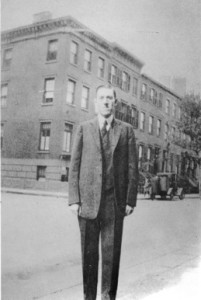Mischievously sweet, Narragansett’s Lovecraft Honey Ale is, the Providence-based brewery admits, “a little…strange.” “Think of this brew as our bold, our obscure, our tampered with mind,” brewer Mark Hellendrung remarks. “It won’t be for everyone, and if it isn’t for you, you’ll know exactly who it is for.” While the ale is meant to honor the master of horror and Providence native Howard Phillips Lovecraft, the man himself would have been scandalized by this “honor,” as he was a strong proponent of Prohibition. His aversion to booze was only one of many peculiarities, peculiar being the crucial word. Understanding Lovecraft and the development of his oddities goes a long way in understanding his works.
Lovecraft was born on August 20, 1890 to Winfield and Sarah Susan Lovecraft. His parents were in love and his childhood should have been a happy one, but just three years after Howard’s birth, Winfield was institutionalized for mental illness and nervous exhaustion, probably symptoms of syphilis. He died five years later. Young Lovecraft was kept in the dark about his father’s illness and never visited him in the sanitarium. Though he didn’t know the cause of his father’s absence, he felt it keenly. Lovecraft was a melancholy child and after his father died, he suffered from fits of depression that would plague him for the rest of his life.
As a result of his father’s untimely death, Lovecraft was raised by his mother and aunts. Sarah Lovecraft had badly wanted a daughter, and until Lovecraft was six, his mother dressed him in frocks and let his golden hair grow long. This only stopped after Lovecraft threw the tantrum to end all tantrums, which convinced Sarah to cut his hair and let him wear trousers. Not surprisingly, Lovecraft was the weird kid on the block, and he didn’t have many friends in his youth.
To escape the isolation of his everyday life, Lovecraft picked up some peculiar literary habits. His grandfather taught him to read before he was school-aged, and he sped through Grimm’s Fairy Tales when he was four. Remember, these aren’t the Disney tales you and I know. These are the stories where Cinderella’s stepsisters cut off their own feet and a twelve-year-old Rapunzel gives birth to twins after being abandoned in the forest. At six, he obsessed over Samuel Taylor Coleridge’s “The Rime of the Ancient Mariner.” His first written work was an 88-line poem inspired by Alexander Pope’s Odyssey, completed right before his seventh birthday. Nowadays, most people read these works in college, but Lovecraft burned through them like they were Fun with Dick and Jane before he reached the third grade.
Lovecraft continued to write poetry and prose prolifically throughout his childhood. Because frequent illnesses kept him out of school, he supplemented his education by reading anatomy and astronomy texts. He even published his own weekly astronomy periodicals to pass the time. He printed them on a hectograph supplied by his mother, and while it was an expensive habit, it kept him happy.
But when he turned 18, Lovecraft had a mental breakdown.
For five years he rarely left the house and wrote absolutely nothing. Reflecting upon this time, he wrote, “I perceived with horror that I was growing too old for pleasure. Ruthless Time had set its fell claws upon me… Adulthood is hell.” Lovecraft was so petrified of growing up that he squandered his adolescence.
Eventually, he began to write again, and many of his early works were published as “pulp fiction” for very little profit. His first stories were often based on his dreams; he wanted to provide an alternative to realism, which he despised. For Lovecraft, nothing could be written in a realist way that hadn’t already been said. Anything about a typical American family or a gritty portrait of the life of the poor was a waste of space—completely unoriginal, no matter how well written.
In 1921, just a few days after the death of his mother, Lovecraft met a journalist seven years his senior named Sonia Greene. Against the wishes of his extended family, Lovecraft married Greene in 1924 and moved from Providence to her apartment in New York. Greene owned a successful hat shop and promised to support Lovecraft financially while he pursued his writing career. It seemed like a pretty cushy arrangement, and Lovecraft began entertaining ideas of fame as a writer.
But his time in New York was not the boon he had hoped. Lovecraft managed to make a few writing connections, but the nightlife of the Roaring Twenties didn’t appeal to him. He was a teetotaler and looked down on anyone who drank alcohol. His puritanical views translated to the bedroom, which, as you can probably imagine, strained his relationship with Greene. On top of that, she lost her shop, putting pressure on Lovecraft to sell stories. Greene then moved to Ohio to support the both of them, leaving Lovecraft in New York. While he was living there alone, the apartment was burgled, he lost a large amount of weight, and he fell sick. On top of all that, he failed to make any money.
New York’s diverse “melting pot” population brought out the nasty white supremacist in Lovecraft. He had always been proud of his ancestry of “unmixed English gentry,” but he began to despise immigrants and viewed himself (and his WASP-y compatriots) as far superior human beings. After two years, Lovecraft left New York and returned to Providence. Greene did not follow, and she eventually filed for divorce. As a Jewish woman, she probably wasn’t impressed by his descriptions of the “rat-faced Jews” and “monstrous half-breeds” of New York City.
For the rest of his life, Lovecraft lived as the “recluse of Providence,” which is where he wrote many of his most famous stories. In some ways, the monsters and gore in Lovecraft’s stories weren’t the most unusual things about them. Money is not mentioned once in any of his work. Neither is sex. Two things that most people count as fundamental to human existence don’t seem to exist in Lovecraft’s fictional canon. Another thing that doesn’t play a big part in Lovecraft’s composition: women. Female characters are rarely featured, and only two stories have female protagonists (one of them, “The Curse of Yig”, was probably not coincidentally a collaboration with a woman). Lovecraft had a lot of anxiety about sex and money in real life, so in his fictional worlds, he could pretend that they didn’t exist.
Although he viewed his stories as detached from the world he lived in, Lovecraft’s beliefs, even the unsavory ones, worked their way into his writing. As an atheist, he believed that humans did not occupy a special place in the universe. To him, life meant nothing, but neither did death; this belief might’ve enabled him to write such gory and graphic scenes. His proclivity for reading science textbooks made his horror a sensory experience—the more detailed and mechanical the descriptions, the more terrifying it became.
Unfortunately, his racism also played a big part in his storytelling. The monsters in his stories, like Cthulhu and the Night Gaunts, are combinations of man and animal, a literary manifestation of his fear of miscegenation. His heroes, and often the victims of these monsters, are upstanding men of society: white English-American professors. Though he claimed that the best fiction was completely removed from reality, Lovecraft’s own prejudices were put on display in his short stories.
Despite his Anglophilia, Lovecraft never left the United States during his lifetime. In fact, he rarely left New England. It was during this time, late in his life, that he published his most famous works in Weird Tales magazine, such as the Cthulhu mythos and “The Dunwich Horror.” He never attained any fame during his life, but he did amass a small number of acolytes. Young writers, such as Robert Bloch, exchanged letters with Lovecraft asking for guidance. Although he had clout in his small circle of writers, Lovecraft died nearly penniless at 46 of intestinal cancer.
Lovecraft biographer Michel Houellebecq stated that when “Lovecraft died, his work was born.” Shortly before his death and for a long while after, burgeoning science fiction and horror writers like August Derleth and Clark Ashton Smith established their careers writing additions to the Cthulhu mythos, which helped expose new readers to Lovecraft’s work. Nearly 20 years after Lovecraft’s death, Weird Tales magazine was still publishing new stories in the Cthulhu canon as a kind of institutionalized fan fiction.
And now, almost 80 years after his death, the conventions created by Lovecraft still pervade the horror genre and beyond. Ridley Scott’s Alien and The X-Files wouldn’t exist without Lovecraft, but neither would Dungeons and Dragons. Lovecraft and his creations are iconographic to horror fans, but when you delve into his twisted world, you see he was a regular man. He was flawed, weird, and isolated. In many ways, he was a typical nerd, making his work that much drearier. To celebrate the man and his works, try a Lovecraft Honey Ale and check out some modern works inspired by his ideas.
Header image via Comic Booked. Images of Lovecraft via HPLovecraft.com.





